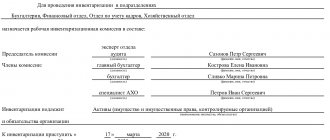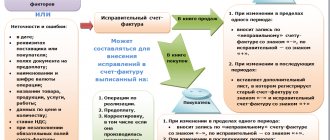Inventory – checking the presence, condition and assessment of the organization’s property and liabilities. In what cases is an inventory carried out? It is worth noting that inventory can be mandatory or voluntary. That is, in some cases, organizations can independently determine the feasibility of the procedure.
In what cases is an inventory carried out? Are all companies required to carry it out?
Inventory is carried out by all companies without exception, regardless of taxation regime, number of employees, etc. Thus, the use of a special regime (for example, the simplified tax system) is not an exemption from conducting an inventory. All companies that maintain accounting are required to conduct an inventory.
Purpose of the process
You may be interested in: Which bank is better to invest money in? Review of rates on bank deposits
Many novice entrepreneurs wonder whether it is necessary to carry out an inventory and what goals can be achieved through this process. The procedure is represented by a systematic accounting of material assets and assets, for which actual indicators are compared with data from official documents.
You may be interested in: Aroon indicator: description of the indicator, application in trading
The main purpose of inventory is to identify discrepancies. They can appear for various reasons:
- impact on values of factors of a natural nature, therefore this includes shrinkage, damage due to improper storage, evaporation or loss occurring during the transportation of goods;
- illegal actions on the part of company employees, for example, taking incorrect measurements, allowing body kits, or even stealing valuables;
- problems that arise during accounting, therefore, after the inventory, various errors, corrections, inaccuracies, clerical errors or other ambiguities in documents are often identified.
Channel PROGRAMMER'S DIARY
The life of a programmer and interesting reviews of everything. Subscribe so you don't miss new videos.
Based on this, a systematic audit allows any company manager to promptly identify various violations and problems.
Penalty for failure to take inventory
The tax inspectorate or other government agencies cannot fine an organization simply because it did not conduct an annual inventory. There is no such fine in the law.
However, without inventory:
- it is impossible to obtain a positive audit opinion;
- accounting statements may be unreliable, which entails fines both for the organization itself and for its officials (Article 120 of the Tax Code of the Russian Federation; Article 15.11 of the Code of Administrative Offenses of the Russian Federation);
- errors in tax accounting, additional charges of taxes, penalties and fines are possible (Articles 75, 120, 122 of the Tax Code of the Russian Federation).
Verification functions
You may be interested in:Engineering preparation of a construction site: basic rules
Carrying out an inventory of goods necessarily involves the use of various functions of the procedure:
- The conditions under which various goods are stored are objectively assessed, and such an assessment is objective.
- It is determined how correctly and competently the maintenance of various documents is carried out in the company.
- The features of warehouse management in the company are reflected.
- The completeness and accuracy of accounting is assessed.
- Grants are provided for the prevention of various abuses and violations on the part of hired specialists.
Due to such numerous functions, inventory is considered an important process in any company.
Cases of mandatory inventory
Some companies are required to carry out the procedure based on legal requirements. Information on in which cases an inventory is mandatory is contained in the following regulations:
The check must be carried out in the following situations:
- when providing property for rent;
- sale or repurchase of assets owned by the company;
- transformation of a state or municipal enterprise;
- before preparing annual reports;
- when appointing a new financially responsible person in the company;
- upon detection of damage to valuables or theft of property;
- after natural disasters or other emergencies;
- during company reorganization;
- before the liquidation of the organization;
- in other situations provided for by law.
Carrying out an inventory is mandatory before preparing annual reports. This process allows not only to take into account legal requirements, but also to prevent various errors or shortcomings in accounting papers. Typically, companies perform the review annually before the end of the calendar year.
Inventory of fixed assets is carried out every three years. Every manager should know all cases of mandatory inventory. Additionally, he can independently order an inspection if there are doubts about the integrity of the work of certain hired specialists.
You may be interested in: Residential complex "Peredelkino Blizhnoe": reviews, advantages and disadvantages
Inventory - when to carry out, what to take inventory of, how to register?
To assess the real financial condition of an organization, it is necessary to have reliable data about all the property at its disposal: availability, quantity, condition in which this property is located, and the correctness of its value. This real state must be compared with accounting data. This process of checking assets and liabilities is called an inventory.
Inventory is a control function of accounting that allows you to identify cases of unjustified reduction of the company's capital invested in various types of property (assets).
Inventory is a mechanism to ensure the accuracy of accounting. Accounting and reporting may be correct on paper, but their accuracy can only be determined through inventory. Legislation provides organizations with ample opportunities to use inventory as an effective mechanism for regulating and monitoring the procedure for maintaining accounting records of the financial and economic activities of an organization in order to prepare reliable information about its financial position in the financial statements.
Each organization is obliged to conduct an inventory of its property before the start of drawing up annual reports - this obligation is established by Art. 12 of the Federal Law of November 21, 1996 No. 129-FZ “On Accounting”. The procedure for conducting an inventory of the organization’s property and liabilities must be prescribed in the accounting policy - this must be done at the beginning of the year, guided by clause 3 of Art. 6 of Law No. 129-FZ.
On January 1, 2013, the Federal Law of December 6, 2011 No. 402-FZ “On Accounting” will come into force. The new Law also provides for the obligation of organizations to conduct an inventory (Article 11 “Inventory of assets and liabilities”):
- Assets and liabilities are subject to inventory.
- During the inventory, the actual presence of the relevant objects is revealed, which is compared with the data of the accounting registers.
- The cases, timing and procedure for conducting an inventory, as well as the list of objects subject to inventory, are determined by the economic entity, with the exception of the mandatory inventory. Mandatory inventory is established by the legislation of the Russian Federation, federal and industry standards.
- Discrepancies identified during the inventory between the actual availability of objects and the data of the accounting registers are subject to registration in accounting in the reporting period to which the date as of which the inventory was carried out refers.”
When to carry out an inventory
The period for carrying out an inventory before drawing up annual financial statements is determined by the head of the organization, except for cases when carrying out an inventory is mandatory. Organizations usually conduct it at the end of the reporting year. However, some organizations do this in advance, after October 1, since they can make the necessary accounting adjustments before the end of the year. This opportunity is provided by clause 27 of the Regulations on maintaining accounting and financial statements in the Russian Federation, approved by order of the Ministry of Finance of Russia dated July 29, 1998 No. 34n (as amended on December 24, 2010). This paragraph, in particular, states that if the inventory of property was carried out after October 1 of the reporting year, then it is no longer necessary to carry it out a second time before drawing up the annual financial statements. In practice, it is most rational to print and distribute acts of reconciliation of mutual settlements with counterparties in October–November with data as of September 30 or October 31. Similarly, an inventory of fixed assets and inventory balances can be carried out in October.
In paragraph 2 of Art. 12 of Law No. FZ-129 presents cases when inventory is required:
- when transferring property for rent, redemption, sale, as well as during the transformation of a state or municipal unitary enterprise;
- before preparing annual financial statements;
- when changing financially responsible persons;
- when facts of theft, abuse or damage to property are revealed;
- in the event of a natural disaster, fire or other emergency situations caused by extreme conditions;
- during reorganization or liquidation of the organization;
- in other cases provided for by the legislation of the Russian Federation.
What do we check (inventory)?
According to paragraph 1 of Art. 12 of Law No. 129-FZ, organizations are required to conduct an inventory of property and liabilities, during which their presence, condition and assessment are checked and documented. Thus, you need to check (if listed on your balance):
- intangible assets;
- fixed assets;
- financial investments;
- inventory items;
- work in progress and deferred expenses;
- cash, monetary documents and strict reporting document forms;
- settlements with suppliers, buyers, tax authorities and funds, settlements with other debtors (creditors);
- reserves for future expenses and payments, estimated reserves.
What is needed to carry out an inventory?
According to clause 2.2 of the Methodological guidelines for the inventory of property and financial obligations, approved by order of the Ministry of Finance of Russia dated June 13, 1995 No. 49 (as amended on November 8, 2010), the organization must have a permanent inventory commission, and in case of a large volume of work To simultaneously carry out an inventory of property and financial obligations, it also creates working inventory commissions. Usually it includes representatives of the administration, accounting workers, as well as other specialists (engineers, economists, technicians, etc.). In addition, representatives of the organization’s internal audit service and independent audit organizations can be included in the inventory commission. However, when staffing the commission, the manager must take into account the following rule: the commission should include only those specialists who will definitely be present during its conduct, since the absence of at least one member of the commission during the inventory serves as a basis for invalidating the inventory results (clause 2.3 of the Methodological Instructions ). The main goals of the inventory are: identifying the actual availability of property; comparison of the actual availability of property with accounting data; checking the completeness of recording of liabilities.
The procedure for taking inventory of property
The inventory procedure consists of several stages. Forms for recording inventory results were approved by Decree of the State Statistics Committee of Russia dated August 18, 1998 No. 88 (as amended on March 27, 2000). The first stage is preparatory:
- preparing property (for example, inventory) for inventory;
- preparation of documents necessary for conducting an inventory; issuing an order (resolution, instruction) on conducting an inventory in form No. INV-22;
- creating a list of employees for inventory;
- determining the timing and types of inventory property;
- printout of inventory lists of inventory items (form No. INV-3) separately for each financially responsible person.
Before starting to check the balances of property, the inventory commission must receive the latest incoming and outgoing documents or reports on the movement of material assets and funds at the time of inventory, and the chairman of the inventory commission must endorse them with the indication “before inventory on “__________” (date).” . In addition, the materially responsible persons of the organization must give receipts that by the beginning of the inventory they had handed over to the accounting department or handed over to the commission all expenditure and receipt documents for the property, as well as that all valuables received under their responsibility were capitalized, and those disposed of - written off as expense. Similar receipts are also given by persons to whom accountable amounts were issued for the purchase of property or a power of attorney to receive it. An order (resolution, instruction) (form No. INV-22) is a written task specifying the content, volume, procedure and timing of the inventory of the inspected object, as well as the personal composition of the inventory commission. The order (resolution, instruction) is signed by the head of the organization and handed over to the chairman of the inventory commission. The order is registered in the Logbook for monitoring the implementation of orders (decrees, instructions) on the inventory (form No. INV-23). I recommend not proceeding with the second stage of inventory until the first stage is properly completed.
In inventory, procedure is very important. Since very often the results of the inventory can reveal real shortages, which will entail consequences for financially responsible persons. And it is necessary that these persons were already prepared in advance for the fact that their work is checked, that all, for example, goods are in the warehouse entrusted to them, recorded and checked - i.e. they are required to sign on the title page of the inventory list INV-3 and be familiar with the Order in the form INV-22. Before taking an inventory, it is also necessary to check the existence of agreements on personal or collective liability and the validity periods of these agreements.
The second stage is the inventory itself (i.e. identifying and checking the actual availability of goods, as well as filling out the corresponding columns in the inventory lists). During the inventory, the commission determines the actual availability of property through its mandatory physical recalculation, weighing and re-measuring. Information about the actual availability of property and the reality of recorded financial obligations is recorded in inventory records, which are drawn up in duplicate. Relevant reports are drawn up for unusable or damaged materials and finished products identified during inventory. When automated processing of data for recording inventory results, form No. INV-3 is issued to the commission on paper or computer media with completed columns from 1 to 9. In the inventory, the responsible persons of the commission fill out column 10 about the actual availability of inventory in quantitative terms. Column 9 “Passport number” is filled in for material assets containing precious metals and stones. If material assets are identified that are not reflected in accounting, the commission must include them in the inventory list. It is not allowed to leave blank lines in inventories; blank lines are crossed out on the last pages. The inventories are signed by all members of the inventory commission and financially responsible persons. At the end of the inventory, the financially responsible persons give a receipt confirming that the commission has checked the property in their presence, that there are no claims against the members of the commission, and that the property listed in the inventory has been accepted for safekeeping. The third stage is a comparison of inventory data with accounting data. At this stage, discrepancies in accounting with actual balances are identified. The head of the organization, together with the employees who carried out the inventory, determines the reasons for the discrepancies; if necessary, the movement of inventory items for the period since the previous inventory is verified. Comparison statements (forms No. INV-18, INV-19) are used to reflect the results of the inventory of fixed assets, intangible assets, inventory, finished products and other material assets for which deviations from accounting data have been identified. The matching statements reflect the results of the inventory, i.e. discrepancies between indicators according to accounting data and inventory records. For valuables that do not belong to the organization, but are listed in the accounting records (those in custody or rented, received for processing), separate matching statements are compiled. The matching statement is drawn up in two copies by the accountant, one of which is kept in the accounting department, the second is transferred to the financially responsible person(s). When filling out the comparison sheet to reflect the results of the inventory of intangible assets (form No. INV-18), columns 3, 8, 10 are not filled in. To identify the results of the inventory of unfinished repairs of fixed assets, deferred expenses, the availability of funds, securities and forms of strict reporting documents, forms No. INV-10, INV-11, INV-15 and INV-16 are respectively used, which combine the indicators of inventory records (acts) and matching statements.
The fourth stage is registration of inventory results. Documents for recording the results of inspections are drawn up with the participation of members of inventory commissions and financially responsible persons. At this stage, accounting data is brought into line with inventory results. Persons guilty of incorrect accounting of property are brought to administrative responsibility, financially responsible persons are held liable in accordance with an individual or collective agreement on financial responsibility. The record sheet for the results identified by the inventory (form No. INV-26) is used to document the inventory and control checks of the correctness of the inventory. The results of the inventory must be reflected in the accounting and reporting of the month in which the inventory was completed, and for the annual inventory - in the annual accounting report.
Inventory of funds, monetary documents and strict reporting document forms
The cash register inventory is carried out in accordance with the Procedure for conducting cash transactions in the Russian Federation, approved by Decision of the Board of Directors of the Bank of Russia dated September 22, 1993 No. 40 (as amended on February 26, 1996). When checking the completeness and timeliness of the posting of funds received from bank accounts, members of the inventory commission should use the method of mutual control. With this method, the amounts reflected in the statement on the debit of account 50 “Cash” are compared with the data of the journal order on the credit of account 51 “Cash accounts”. The indicated amounts must match. It is also necessary to compare the correspondence of the entries in the General Ledger for account 50 and in the turnover sheet. If discrepancies are detected, they are compared using cash receipt orders, bank statements, cashier's reports, check stubs, and, if necessary, checked directly at the bank. Checking the receipt of cash received from the bank should be carried out not only on check counterfoils, but also on bank statements. If there are traces of erasures, corrections, or if there is a discrepancy in the balance amounts, you should obtain an extract from the current account from the bank and compare the entries in the accounting department with the extract data. The write-off of funds is verified against the documents attached to the cash reports. At the same time, you should also pay attention to the clear execution of documents: are there receipts from the recipients, are they canceled with the “Paid” stamp indicating the date, are there any traces of erasures and corrections on them. In addition to the above, during the cash register inventory it is also necessary to check: whether a limit has been set for the cash balance in the cash register; are there any facts of discrepancy between the date in cash receipts and the date of actual disbursement of funds; correct correspondence of accounts according to cash documents; timely deposition of unpaid wages. When taking inventory of the cash register, it is necessary to check whether an agreement has been concluded with the cashier on full financial responsibility and whether the cash register premises are equipped with the necessary means to ensure the safety of funds (technical reinforcement and fire alarm), where duplicate keys to safes are stored. Keys must be kept in sealed bags by the head of the organization. When calculating the actual presence of banknotes and other valuables in the cash register, cash, securities and monetary documents (postage stamps, state duty stamps, bill stamps, vouchers to holiday homes and sanatoriums, air tickets, etc.) are taken into account. Checking the actual availability of forms of securities and other forms of strict reporting documents is carried out by type of form (for example, by shares: registered and bearer, preferred and ordinary) taking into account the starting and ending numbers of certain forms, as well as for each place of storage and material responsible persons. Inventory of funds in transit is carried out by reconciling the amounts listed in the accounting accounts with the data of receipts from a bank institution, post office, copies of accompanying statements for the delivery of proceeds to bank collectors, etc. An inventory of funds held in banks in settlement (current), foreign currency and special accounts is carried out by reconciling the balances of the amounts listed in the corresponding accounts according to the organization’s accounting department with data from bank statements.
Inventory of calculations
An inventory of settlements with banks and other credit institutions for loans, with the budget, buyers, suppliers, accountable persons, employees, depositors, other debtors and creditors consists of checking the validity of the amounts listed in the accounting accounts. Inventory of settlements with suppliers and customers (accounts 60 “Settlements with suppliers and contractors”, 62 “Settlements with buyers and customers” and 76 “Settlements with various debtors and creditors”) is drawn up in a settlement reconciliation act signed on both sides - by the manager (or other authorized person) of the organization and the head (or other authorized person) of the counterparty company. When checking invoice 60, special attention must be paid to goods that have been paid for but are in transit, and settlements with suppliers for uninvoiced deliveries (they must be checked against documents in agreement with the corresponding invoices). For debts to employees of the organization (account 70 “Settlements with personnel for wages”), unpaid amounts for wages are identified that are subject to transfer to the account of depositors, as well as the amounts and reasons for overpayments to employees. When inventorying accountable amounts (account 71 “Settlements with accountable persons”), reports of accountable persons on advances issued are checked, taking into account their intended use, as well as the amount of advances issued for each accountable person (dates of issue, intended purpose). In addition, the inventory commission, through a documentary check, must also establish the correctness and validity of: settlements with banks, financial, tax authorities, extra-budgetary funds, other organizations, as well as with structural divisions of the organization allocated to separate balance sheets; the amount of debt for shortages and thefts listed in the accounting records; amounts of receivables, payables and depositors, including amounts of receivables and payables for which the statute of limitations has expired. For organizations submitting reports to tax authorities via electronic communication channels, it is currently possible to check the status of a personal account electronically. After ordering the reconciliation of the personal account and receiving the results, the accounting department is obliged to reconcile the data and, before drawing up the annual report, sign the Act of joint reconciliation of calculations for taxes, fees, penalties and fines (form according to KND 1160070), approved by order of the Federal Tax Service dated August 20, 2007 No. MM-3 -25/ [email protected] Inventory of reserves for upcoming expenses and payments, estimated reserves When inventorying reserves for upcoming expenses and payments, the correctness and validity of the reserves created in the organization are checked: for the upcoming payment of vacations to employees; for the payment of annual remuneration for long service; for the payment of remuneration based on the results of the organization’s work for the year; expenses for repairs of fixed assets; production costs for preparatory work due to the seasonal nature of production; upcoming costs for the repair of rental items and for other purposes provided for by the legislation of the Russian Federation, regulations of the Ministry of Finance of Russia and industry-specific features of the composition of costs included in the cost of products (works, services), approved in the prescribed manner. Note that if the actually accrued reserve exceeds the amount of the calculation confirmed by the inventory, the organization's accountant must make a reversal entry for the amount of such excess, and in case of underaccrual, make an additional entry to include additional deductions at the expense of the source of its formation.
Practical recommendations
Inventory is often a very painful process, since it reveals not only accounting errors, but also shortages, loss of property, and, as a result, punishment of the guilty parties. Therefore, it is very important to follow the procedure - obtain receipts from financially responsible persons before the inventory, organize the entire process so that all persons responsible for the inventory property participate in the process. For a chain of retail stores, it is advisable to conduct selective inventories, separately for each store. For wholesale companies and for companies providing work and services, the main thing is to timely conduct an inventory of settlements with customers and sign reconciliation reports. Subject to these conditions, in the event of termination of payment or bankruptcy of the counterparty company, the organization will have evidence of recognition of the debt by this company, i.e. there will be grounds for going to court. For large buyers, it is possible to sign documents quarterly. It is necessary to remember that an inventory must be carried out when changing materially responsible persons, for example warehouse workers, as well as when changing the general director. Accountants should remember to sign an annual reconciliation report with the tax office. When changing the legal address or changing the owner, a signed reconciliation report will facilitate the transition to the new tax office, as tax balances will be confirmed. Inventory is a process that reveals how things are going in the company not only with accounting, but also with discipline, contractual work (the presence of agreements on individual or collective liability), and document flow. If you carry out inventory informally, you can improve the work of many departments of the company. It should be remembered that inventory is a mandatory process to confirm the accuracy of data in accounting and reporting.
Author: Irina Anoshina, Head of Accounting Practice Department, BDO Outsourcing Division
You can read the full version of the article in Financial Newspaper No. 3, and the continuation in No. 4, January 2012.
How the order of the process is established
Carrying out an inventory necessarily involves taking into account the requirements contained in the Methodological Recommendations. Numerous nuances are determined by the immediate managers of the companies. For this purpose, the rules are fixed in the constituent documentation.
The director of the company can determine some important points:
- when the process needs to be executed;
- how many times a year can inventory be taken;
- at what time the process takes place;
- how long does it last;
- what assets are necessarily checked;
- who is a member or chairman of the inventory commission.
The answers to all these questions are fixed in the constituent documentation. Carrying out an inventory is mandatory when changing financially responsible persons. Under such conditions, a new hired specialist can be sure that the shortcomings that arose under his predecessor will in no way be transferred to him.
What is being checked?
Inventory can be carried out in relation to different property, so checking of cash, fixed assets, materials or other items is highlighted. During the procedure, all assets and liabilities existing in the company and its divisions are assessed. The following elements are checked:
- fixed assets of the company used to conduct business;
- intangible assets of the company;
- various financial investments;
- goods and materials;
- unfinished production;
- money in accounts and in the cash register;
- securities and BSO;
- settlements with counterparties, buyers, the Federal Tax Service, various funds and other debtors or creditors;
- reserves;
- assets and liabilities of the enterprise.
In what cases is it necessary to conduct an inventory of materials? Such a check is carried out when there are suspicions that hired specialists in the company are abusing their powers, so theft or shortage is detected.
Not only the property owned by the company is subject to inspection, but also the assets located on off-balance sheet accounts. The enterprise does not have ownership rights to them, but they are used in the process of work on the basis of a lease agreement or other agreements.
Capitalization of surplus
Assets found to be in surplus are subject to capitalization and credited to the financial results of the organization (clause 5.1 of the Methodological Instructions for Inventory).
In tax accounting, surpluses are included in non-operating income at market value (clause 8, clause 20 of Article 250 of the Tax Code of the Russian Federation, Letter of the Ministry of Finance of Russia dated September 11, 2020 N 03-11-06/2/80113). The market value is determined taking into account the provisions of Art. 105.3 of the Tax Code of the Russian Federation (clause 5 and article 274 of the Tax Code of the Russian Federation, Letter of the Ministry of Finance of Russia dated August 28, 2020 N 03-03-06/1/75787). Depreciation can be calculated on capitalized fixed assets, but bonus depreciation cannot be applied.
Inventory and materials are taken into account as usual. This property may be written off or sold. As for sales, the income received as a result of such transactions is reduced by the amount of the market value of the property being sold (accounted for as non-operating income), at which it was accepted for accounting (clause 2, clause 1, article 268 of the Tax Code of the Russian Federation, Letter of the Ministry of Finance of Russia dated September 23 .2011 N 03-03-06/1/583, dated 02/11/2011 N 03-03-06/1/88, Resolution of the Federal Antimonopoly Service of the Moscow Region dated 02/21/2013 in case N A40-2055/12-20-9).
Process steps
Carrying out an inventory of property necessarily involves performing sequential actions. Therefore, the process is divided into stages:
The inventory must be completed before the actual preparation, signing and submission of annual reports to the Federal Tax Service. The inventory procedure necessarily ends with the preparation of a special report.
Write-off of bad debts
Bad debts are written off on the basis of an inventory of payments (form INV-17) and an order from the manager (clause 77 of the Accounting Regulations No. 34n, Article 266 of the Tax Code of the Russian Federation, Letter of the Ministry of Finance of Russia dated December 27, 2018 No. 03-03-06/1/ 95709, dated 10/13/2017 N 03-03-06/1/67057, dated 07/11/2017 N 03-03-06/1/43877).
Uncollectible accounts receivable are subject to write-off against the allowance for doubtful debts. If the reserve is not enough, the remaining debt goes to expenses (Article 265 of the Tax Code of the Russian Federation, Letter of the Ministry of Finance dated January 16, 2018 N 03-03-06/2/1551). In accounting, all organizations are required to create such a reserve; in tax accounting, this is the right of the organization (clause 70 of Regulation No. 34n, Article 266 of the Tax Code of the Russian Federation, Letter of the Ministry of Finance of Russia dated August 31, 2020 No. 03-03-06/2/76195).
The receivable is subject to write-off as expenses along with VAT (Article 266 of the Tax Code of the Russian Federation, Letter of the Ministry of Finance dated October 21, 2008 N 03-03-06/1/596). According to the Ministry of Finance, when writing off debts on advances issued, the VAT accepted for deduction from this advance payment must be restored (Letter of the Ministry of Finance dated January 28, 2020 N 03-07-11/5018).
After write-off, bad receivables are reflected in off-balance sheet account 007 for five years (clause 77 of Regulation No. 34n).
Under the simplified tax system, written-off receivables are not taken into account either in expenses or in income (Letters of the Ministry of Finance dated 02/20/2016 N 03-11-06/2/9909, dated 07/22/2013 N 03-11-11/28614).
Bad accounts payable are taken into account as income under both the OSNO and the simplified tax system (clause 78 of Regulation No. 34n, clause 2, clause 1, article 248, clause 18, article 250, clause 1, article 346.15 of the Tax Code of the Russian Federation). If an organization uses the simplified tax system to write off the creditor for the advance received from the buyer, then no income will arise, because income is reflected as the advance payment is received (clause 1 of Article 346.17 of the Tax Code of the Russian Federation, Letter of the Ministry of Finance of Russia dated March 14, 2016 N 03-11-06/2/14135).
Writing off accounts payable to the supplier does not oblige the buyer to restore VAT previously accepted for deduction (Letter of the Ministry of Finance dated June 21, 2013 N 03-07-11/23503). When a creditor writes off an advance received, the VAT calculated on it cannot be deducted. There is no need to include it in income or expenses (Article 248 of the Tax Code of the Russian Federation, Letter of the Ministry of Finance dated December 7, 2012 N 03-03-06/1/635).
Report writing rules
Based on the results of the inspection, a report is generated. It includes the following information:
- date of inventory;
- information about the members of the inventory commission;
- the period during which the procedure was performed;
- the company's property being inspected;
- identified problems and shortcomings;
- signatures of all inspectors.
Although conducting an inventory is mandatory before preparing annual reports, any company manager can begin the process without good reason. To do this, an appropriate order is issued, after which the company’s employees are required to follow the procedure.
Responsibilities of the inventory commission
You may be interested in: A loan secured by real estate is... Definition, types of loans, registration stages, expert advice
Carrying out an inventory is mandatory by law, so every company must create a special body responsible for inspection and accounting. It is called the liquidation commission. She has some responsibilities:
- the use of various preventive measures aimed at preserving the property of the enterprise;
- participation in various disputes related to the storage or damage of property values;
- control over the correctness of drawing up various documents relating to the company’s property;
- Carrying out an inventory based on the order of the company management;
- preparation of a report on the results of the inspection;
- conducting an investigation aimed at identifying the culprit of various violations and problems.
All these actions should be performed exclusively by company employees who are not interested in the results of the audit.
Who is on the commission
When forming a commission, the following specialists are usually involved:
- administrative workers;
- accounting department specialists;
- internal auditors;
- often even independent experts are involved;
- representatives of various positions available in the organization’s staffing table.
If the company has a small amount of different property, then often the responsibility for conducting an inventory is transferred to the audit commission, if the company has one.
If during the inspection it is revealed that even one member of the commission is absent, then the results of the procedure are considered invalid.
Recommendations from experts
When conducting an inventory in a company, it is advisable to use certain recommendations. These include the following:
- 10 days before the inspection, the manager issues a corresponding order, which is recorded in the journal.
- It is allowed to form a commission not only permanent, but also one-time or working.
- If an organization uses a lot of inventory items, then the decision on the need to conduct a random inventory is made by the manager based on the current situation in the company.
- All members of the commission must be involved in the verification, otherwise the results are easily invalidated.
- During the process, financially responsible persons are involved.
- The company's management must provide conditions for the process to be completed quickly and easily.
- Verification often takes quite a long time, and this is especially true for companies that use a large number of materials or ship and receive many goods.
During the inventory, commission members must take into account legal requirements.
Write-off of shortages
Shortages within the limits of the norms approved by law are written off by order of the manager as production and distribution costs (clause 5.1 of the Inventory Guidelines).
In tax accounting, non-operating expenses take into account shortages of material assets in production and warehouses, at trading enterprises in the absence of culprits, as well as losses from theft, the culprits of which have not been identified. In these cases, the fact of the absence of perpetrators must be documented by an authorized government body (clause 5, clause 2, article 265 of the Tax Code of the Russian Federation).
The norms of the Tax Code of the Russian Federation do not contain instructions on what specific documents need to be obtained in order to confirm the absence of guilty persons, and thus does not limit the taxpayer in confirming the legality of accounting for relevant expenses (Letter of the Ministry of Finance of the Russian Federation dated December 8, 2017 N 03-03-06/ 1/81919).
Documentary evidence may be, in particular, a copy of the resolution of the investigator of the internal affairs bodies of the Russian Federation on the suspension of the preliminary investigation in a criminal case due to failure to identify the person to be brought as an accused (clause 1, paragraph 1, article 208 of the Code of Criminal Procedure of the Russian Federation, Letters of the Ministry of Finance of Russia from 16.12.2011 N 03-03-06/4/149, dated 03.08.2011 N 03-03-06/1/448).
If the guilty person is discovered, then a claim for compensation for losses from the theft of funds can be presented by the organization to the guilty person in accordance with the civil legislation of the Russian Federation. Amounts received to compensate for losses are non-operating income (clause 3 of Article 250 of the Tax Code of the Russian Federation), and the cost of lost property is an expense (clause 20 of clause 1 of Article 265 of the Tax Code of the Russian Federation, Letter of the Ministry of Finance of the Russian Federation dated August 27, 2014 N 03- 03-06/1/42717).







